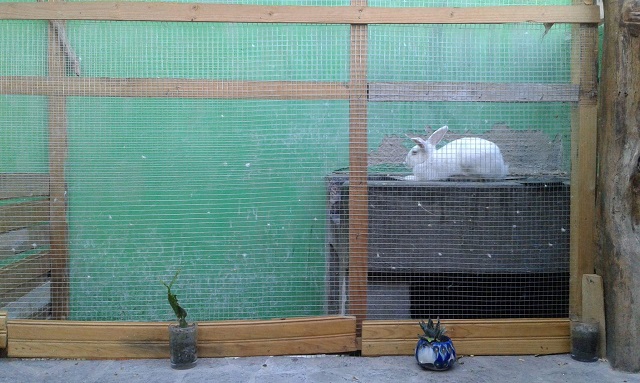
*Warning: bad things happen to bunnies below. ~ Khara, editor.
~
It was mid-December, 2016.
I had agreed to help open a restaurant in San Marcos la Laguna, Guatemala.
Farm to table, as fresh as possible. That was the goal.
One of the menu offerings was rabbit. Market price. Must be reserved at least 24 hours in advance.
I have always been curious to get more closely involved in the process of where meat comes from, and one of the things that convinced me to join this project was the opportunity to do just that. We decided, one day, to run through the dishes so I could get more familiar with the menu. When I arrived, Brad and Sarah were already at work on the day’s prep. We ran through a few veggie tapas, marinated salads, sourdough bread, and fries. Things I had done hundreds of times before in a similar manner.
Then it came to midday. “We want to try another rabbit before we open; we’ve been dialing in the process.”
That was how it opened. Trying a rabbit. One little fluffball “tried” on one count of being delicious and two counts of being in the wrong place at the wrong time. It just so happened that a yoga retreat and farm nearby had a few rabbits that were getting old and the farm was becoming overpopulated with them. We grabbed an 18-inch section of heavy metal pipe, a thick re-usable grocery sack, and I tried to contain my nervousness.
A 10-minute walk further into the valley, and we turned up a staircase cut into volcanic rock that leads to the yoga forest. Upon arrival, there was a group of yogis ordering and eating lunch. All here on a peaceful retreat, escaping into the mountains of Guatemala to get away from the normal pace of life.
“Try not to do it within sight of the guests,” the manager advised us. As if we hadn’t taken into account that witnessing a bunny murder might put a dampener on your morning vinyasa flow.
We met with one of the local workers who took us to a well-populated rabbit cage. He carefully selected one of the larger rabbits, grabbed it by the ears, and plopped it into our sack. We then walked around to an area where various construction materials lay scattered, away from the guests.
It was at this point that my stomach began to tie in a knot. I had never directly witnessed the murder of an animal for food, other than a chicken that was already quite injured and suffering, during my childhood.
The worker grabbed the rabbit from the sack and placed it onto the ground. We helped calm the rabbit and petted it. It appeared to be horrified. Rabbits have a certain level of sentience to them that chickens do not possess. At no point in the killing of a chicken does it seem to know what’s going on.
The rabbit had a strange sadness in its gaze. I swear he looked right into my eyes, begging for freedom. I started to second-guess if this was really a project I wanted to be involved with. I secured the rabbit’s back legs while Brad held his ears. We elongated the rabbit, slowly, and lifted him off the ground a bit. He seemed to be calm but no doubt sensed what was transpiring. With a swift knock, Brad lowered the pipe into the back of the rabbit’s neck. The rabbit twitched a bit and, after another quick knock, fell limp.
It was a moment of internal struggle. Had I really restrained an innocent animal while someone else took its life? I felt a heavy weight of guilt rush over me. As we walked back to the restaurant, lots of feelings flowed through me, and a sudden karmic debt began to sink in.
A couple whacks with a machete removed the rabbit’s head, and we suspended him by his hind legs on a clothesline. A cleaver removed the feet with little effort. Then we slowly and meticulously removed his sweater, starting with the chest and front legs. You have to be quite careful when entering the abdominal cavity of the rabbit. You don’t want to sever any of the intestines, or the spleen—anything that can contaminate the meat. We gutted the critter like a couple of newly certified surgeons.
After “processing” the rabbit to the point of it looking more like grocery-store fare than a hopping, nose-twitching pet, I showed Brad how I would break down a rabbit. We took off the front legs, the flank, and hindquarters. We removed the rib cage from the loin. This part was all-too familiar to me, breaking down an already processed “piece of meat.”
An hour brine. A quick rinse. A two-hour marinade. Grilled with some olive oil, thyme, rosemary, citrus, salt, and freshly cracked pepper—our furry little friend was delicious.
I was not sure how to feel.
On one hand, we had killed him, yes. In a rabbit’s natural environment, he has a rough life. Lots of predators, scarcity of food, competition of mates. Here he had a cage that kept him secure from dogs and other animals. There were plenty of lady-bunnies to go around. It was basically a constant orgy for him. And, instead of being ripped apart and eaten alive by god-knows-what, his spinal column was carefully severed with a quick blow, paralyzing and killing him almost instantaneously.
At least that is how I managed to rationalize it to myself.
That night when I returned to my little cabin in the woods, I walked in the door to find my vegan girlfriend sitting on her yoga mat, stretching.
“How did work go today?” she asked me. I knew I was looking quite distressed and defeated.
“Don’t ask questions you don’t want to know the answer to,” I suggested.
She wanted to hug me. But not before I washed off the stench of death and changed clothes.
It was about a week later when someone ordered the first rabbits. It was not just one, however, it was five.
We went through the same routine, but when the rabbit was secured and stretched out, it was now my turn to hold the pipe. I held the defenseless little animal by his ears and stared him in the eyes. I tried to say a little prayer in my head for him. To send him some sort of I’m sorry and I really appreciate you dying for our epicurean enjoyment energy.
Then I did it. I broke his cute little spine with a foot-and-a-half of pipe. I wanted to vomit. I’m way too empathetic for this sh*t, I thought.
Back in the day, when animals were to be slaughtered, it was always the priest or the holy men who did it. The same person could never do it two days in a row. You didn’t want to become desensitized to the process of taking another being’s life.
So we took turns. Knocking the daylights out of five cute little rabbits. One by one. Walking back to the door of the cage and asking, “Who wants to go next?” until a fat enough rabbit walked up as volunteer.
That was the easy part. By the time we had them all skinned and cleaned, it had been several hours. I had plenty of time to question my meat-eating ways and whether any of this was right. I was angry that because someone else had a few little pieces of paper and the will to eat, that I somehow had to wield the karmic debt of passing that animal on to the afterlife.
I got home defeated and disgusted. I stretched. I burnt palo santo, meditated for a while, and at some point managed to forgive myself.
Somewhere in the sands of time we have become separated from this process, and for good reason. It’s a lot harder to eat a “chicken tender” if it is still part of a living being staring you in the eyes; if you have to feel the warmth of the creature’s flesh as you remove its colorful entrails only moments after you take its life.
Will I stop eating meat? No. Will I eat less of it? Certainly. I have a newfound respect that can only come from being the active “gatherer” of your own meat, of taking another animal’s life force; of getting back to our carnal instincts—survival of the fittest.
I could never be a butcher. It just wouldn’t work for me. But I now have more respect for the people who take the first step toward a nicely displayed, nitrate-laden, reddish-pink steak sitting at your grocer counter.
Next time you go to pick up dinner, think beyond a monetary price. Think beyond “organic” or “all natural.” Think about where the animal came from, what kind of life it lived, and, more importantly, what kind of death it died.
And, if that’s not something we as a society want to think about…maybe we should consider why?
~
Author: Micah Franz
Image: Author’s own
Editor: Khara-Jade Warren











Read 0 comments and reply